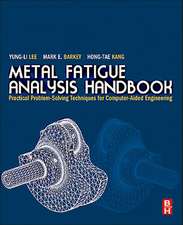Nanomaterials: Mechanics and Mechanisms
Autor K.T. Rameshen Limba Engleză Paperback – 12 oct 2010
| Toate formatele și edițiile | Preț | Express |
|---|---|---|
| Paperback (1) | 699.77 lei 43-57 zile | |
| Springer Us – 12 oct 2010 | 699.77 lei 43-57 zile | |
| Hardback (1) | 648.24 lei 43-57 zile | |
| Springer Us – 14 mai 2009 | 648.24 lei 43-57 zile |
Preț: 699.77 lei
Preț vechi: 823.26 lei
-15% Nou
Puncte Express: 1050
Preț estimativ în valută:
133.94€ • 145.54$ • 112.59£
133.94€ • 145.54$ • 112.59£
Carte tipărită la comandă
Livrare economică 21 aprilie-05 mai
Preluare comenzi: 021 569.72.76
Specificații
ISBN-13: 9781441935373
ISBN-10: 1441935371
Pagini: 356
Ilustrații: XXXVII, 316 p. 124 illus.
Dimensiuni: 155 x 235 x 24 mm
Greutate: 0.5 kg
Ediția:2009
Editura: Springer Us
Colecția Springer
Locul publicării:New York, NY, United States
ISBN-10: 1441935371
Pagini: 356
Ilustrații: XXXVII, 316 p. 124 illus.
Dimensiuni: 155 x 235 x 24 mm
Greutate: 0.5 kg
Ediția:2009
Editura: Springer Us
Colecția Springer
Locul publicării:New York, NY, United States
Public țintă
ResearchDescriere
This book grew out of my desire to understand the mechanics of nanomaterials, and to be able to rationalize in my own mind the variety of topics on which the people around me were doing research at the time. The ?eld of nanomaterials has been growing rapidly since the early 1990s. I- tially, the ?eld was populated mostly by researchers working in the ?elds of synt- sis and processing. These scientists were able to make new materials much faster than the rest of us could develop ways of looking at them (or understanding them). However, a con?uence of interests and capabilities in the 1990s led to the exp- sive growth of papers in the characterization and modeling parts of the ?eld. That con?uence came from three primary directions: the rapid growth in our ability to make nanomaterials, a relatively newfound ability to characterize the nanomate- als at the appropriate length and time scales, and the rapid growth in our ability to model nanomaterials at atomistic and molecular scales. Simultaneously, the commercial potential of nanotechnology has become app- ent to most high-technology industries, as well as to some industries that are tra- tionally not viewed as high-technology (such as textiles). Much of the rapid growth came through the inventions of physicists and chemists who were able to develop nanotechnology products (nanomaterials) through a dizzying array of routes, and who began to interface directly with biological entities at the nanometer scale. That growth continues unabated.
Cuprins
Nanomaterials.- Fundamentals of Mechanics of Materials.- Nanoscale Mechanics and Materials: Experimental Techniques.- Mechanical Properties: Density and Elasticity.- Plastic Deformation of Nanomaterials.- Mechanical Failure Processes in Nanomaterials.- Scale-Dominant Mechanisms in Nanomaterials.- Modeling Nanomaterials.
Recenzii
From the reviews:
"This is a very well written book: clear, analyzes and teaches you what it is all about, anticipates questions and answers them. Very reader-friendly, a rather rare quality!"
"It covers all the fundamentals of mechanical properties, written by someone who knows them well, with a sensible approach, covering all the literature up to date and giving you the complete picture as well as the details. One learns not only nanomaterials, but materials in general."
"The book is totally self-contained, covers all the necessary background in mechanics and goes to a good enough level of covering molecular dynamics and carbon nanotubes. It will become indispensible for students/researchers in several of the areas covered: from nano-indentation, to grain size effects, to nano-devices."
"The fact that the author is primarily an experimentalist accounts for a presentation grounded on experiments and what they measure and do not measure (due to limitations), with the theory presented as the quantitative modeling of what is observed, rather than abstract theories of material behavior. I find this extremely valuable in shaping a way of approach that is the way of understanding the leading mechanisms of complex physical phenomena."
“This work is a great resource for any advanced undergraduate or graduate course on mechanical properties of nanomaterials. … Each well-structured chapter first discusses general principles and then focuses on special effects. Chapters end with a problems section and suggestions for further reading. The author provides numerous examples throughout the text, both supporting the general conceptual understanding and showing real-case examples. Summing Up: Highly recommended. Upper-division undergraduates through professionals interested in the mechanical properties and behavior of nanomaterials.” (H. Giesche, Choice, Vol. 47 (3), November, 2009)
"It covers all the fundamentals of mechanical properties, written by someone who knows them well, with a sensible approach, covering all the literature up to date and giving you the complete picture as well as the details. One learns not only nanomaterials, but materials in general."
"The book is totally self-contained, covers all the necessary background in mechanics and goes to a good enough level of covering molecular dynamics and carbon nanotubes. It will become indispensible for students/researchers in several of the areas covered: from nano-indentation, to grain size effects, to nano-devices."
"The fact that the author is primarily an experimentalist accounts for a presentation grounded on experiments and what they measure and do not measure (due to limitations), with the theory presented as the quantitative modeling of what is observed, rather than abstract theories of material behavior. I find this extremely valuable in shaping a way of approach that is the way of understanding the leading mechanisms of complex physical phenomena."
“This work is a great resource for any advanced undergraduate or graduate course on mechanical properties of nanomaterials. … Each well-structured chapter first discusses general principles and then focuses on special effects. Chapters end with a problems section and suggestions for further reading. The author provides numerous examples throughout the text, both supporting the general conceptual understanding and showing real-case examples. Summing Up: Highly recommended. Upper-division undergraduates through professionals interested in the mechanical properties and behavior of nanomaterials.” (H. Giesche, Choice, Vol. 47 (3), November, 2009)
Textul de pe ultima copertă
The enabling science in much of nanotechnology today is the science of nanomaterials; indeed in the broadest sense, nanotechnology would not be possible without nanomaterials. Nanomaterials: Mechanics and Mechanisms seeks to provide an entrè into the field for mechanical engineers, material scientists, chemical and biomedical engineers and physicists. The objective is to provide the reader with the connections needed to understand the intense activity in the area of the mechanics of nanomaterials, and to develop ways of thinking about these new materials that could be useful to both research and application. The book covers all of the fundamentals of the mechanical properties of materials in a highly readable style, and integrates most of the literature on the emerging field of nanomaterials into a coherent body of knowledge.
This volume provides a basic understanding of mechanics and materials, and specifically nanomaterials and nanomechanics, in one self-contained text. Graduate and advanced undergraduate students will find well-organized chapters that provide the necessary background in mechanics, mechanical properties and modeling. The writing style illustrates concepts through quantitative modeling techniques, in contrast to theoretical abstractions of materials behavior. Problem sets within each chapter aim to motivate discussion and further study in this rich and bourgeoning field.
Providing engineers with the knowledge necessary to take full advantage of the tremendous potential of nanomaterials, Nanomaterials: Mechanics and Mechanisms is a valuable teaching/learning tool for mechanical engineering, physics and materials science audiences.
This volume provides a basic understanding of mechanics and materials, and specifically nanomaterials and nanomechanics, in one self-contained text. Graduate and advanced undergraduate students will find well-organized chapters that provide the necessary background in mechanics, mechanical properties and modeling. The writing style illustrates concepts through quantitative modeling techniques, in contrast to theoretical abstractions of materials behavior. Problem sets within each chapter aim to motivate discussion and further study in this rich and bourgeoning field.
Providing engineers with the knowledge necessary to take full advantage of the tremendous potential of nanomaterials, Nanomaterials: Mechanics and Mechanisms is a valuable teaching/learning tool for mechanical engineering, physics and materials science audiences.
Caracteristici
Includes a summary of key mechanics issues and mechanisms associated with nanomaterials
Offers constitutive descriptions of nanomaterials useful to mechanical engineers
Provides engineers with the background needed to take advantage of nanomaterials applications and mechanisms, enhancing modeling and design techniques
Computer lab exercises, available on public domain software, suggested for students
Offers constitutive descriptions of nanomaterials useful to mechanical engineers
Provides engineers with the background needed to take advantage of nanomaterials applications and mechanisms, enhancing modeling and design techniques
Computer lab exercises, available on public domain software, suggested for students









